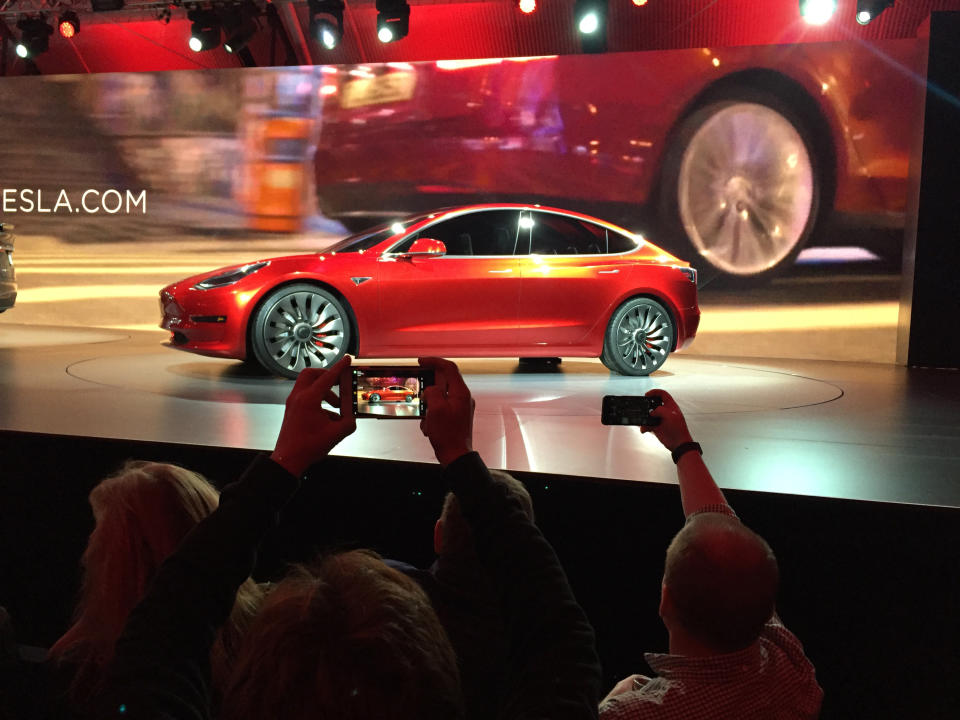3 things Tesla still needs to prove
Nobody calls the BMW 3 series or the Mercedes C Class an “affordable” car. Yet when Tesla (TSLA) announced its plan to sell a vehicle in the same price range, fans raved about a “mass market” vehicle finally coming from the California carmaker.
A true mass-market vehicle would be priced along the lines of a Honda Civic or Toyota Corolla -- $20,000 or so, to start. But never mind -- investors and much of the media bend the rules for Elon Musk, Tesla’s wily CEO. Musk has built a truly remarkable company in Tesla, whose current Model S sedan is beloved by its owners. Yet Musk is also a master of hype who has created expectations that could be impossible to fulfill.
Musk has excited car buffs with his early peek at Tesla’s Model 3, the so-called mass-market car that will start at around $35,000. The prototype is indeed a looker, with taut, aggressive styling and a classy, minimalist interior built around a gigantic touch screen. But building a couple of great cars isn’t enough to survive in an intensely competitive industry with low profit margins. Here’s what else Tesla needs to prove:
Electrics are practical for ordinary people. That includes people who only have one car and take long trips occasionally. Tesla says the Model 3 will fit five and travel more than 200 miles on a charge. That still leaves the question of what to do on longer jaunts. Telsa continues to expand its network of “superchargers,” which can power the vehicle to about 85% of capacity in half an hour (as long as you don’t have to wait for a plug). But many parts of the country still don’t have superchargers, and the more cars Tesla sells, the more crowded those charging stations are going to get.

Meanwhile, oil and gasoline prices seem likely to stay low, meaning gas-powered cars will probably remain the most practical for a long time. Electric vehicles account for just 0.2% of all new-car sales today, according to Kelley Blue Book, and while the share is likely to grow, there’s still no reason to think electrics will become commonplace.
Tesla cars are truly affordable. Many analysts have pointed out that while the Tesla Model S starts at around $70,000, the average selling price is well over $100,000 once upgrades and options are factored in. By the same logic, it wouldn’t be surprising if the average retail price of the $35,000 Model 3 turned out to be more like $40,000 or even $50,000. If so, that would create a big gap between the Model 3 and other electrics, such as the forthcoming Chevrolet Bolt and the next version of the Nissan Leaf. And there are already electrics available for well below $30,000, including a $7,500 federal tax credit. The Kia Soul EV can be yours for as little as $25,000, or $250 per month if you lease. Ford, Chevy, Fiat, Honda, Nissan and Volkswagen all offer EVs for comparable prices, or less.
Telsa can turn a profit on the Model 3. The automaker has never had a profitable year, and it loses nearly $20,000 per vehicle on the Model S. So it’s natural to wonder how a company that can’t make money on a luxury supercar is going to make money on an “affordable” car. Tesla says scale will do the trick, allowing it to sharply lower the cost of battery packs and other components. But it’s also marketing the Model 3 as a smaller replica of the Model S, with many of the same features and only a bit less space. That suggests some customers might put off purchasing a Model S and wait for the Model 3 instead, earning Tesla less revenue rather than more. Further muddling the profitability picture is the supercharger network, which is free to users — but is going to cost Tesla more and more, as the network grows and more owners use it.
The big, boring car companies that sell millions of cars all around the world have true scale, which allows them to spread the cost of new technology among many different vehicles. Even so, Toyota (TM), probably the best of the bunch, had a profit margin of just 8.2% last year, a strong one for auto sales. And Toyota sells 200 times as many cars as Tesla. Musk has a different business model, but even Tesla needs to turn a profit some day. No matter how awesome its cars.
Rick Newman’s latest book is Liberty for All: A Manifesto for Reclaiming Financial and Political Freedom. Follow him on Twitter: @rickjnewman.

 Yahoo Finance
Yahoo Finance 
